Does Age Matter? Trials Finalists by the Numbers
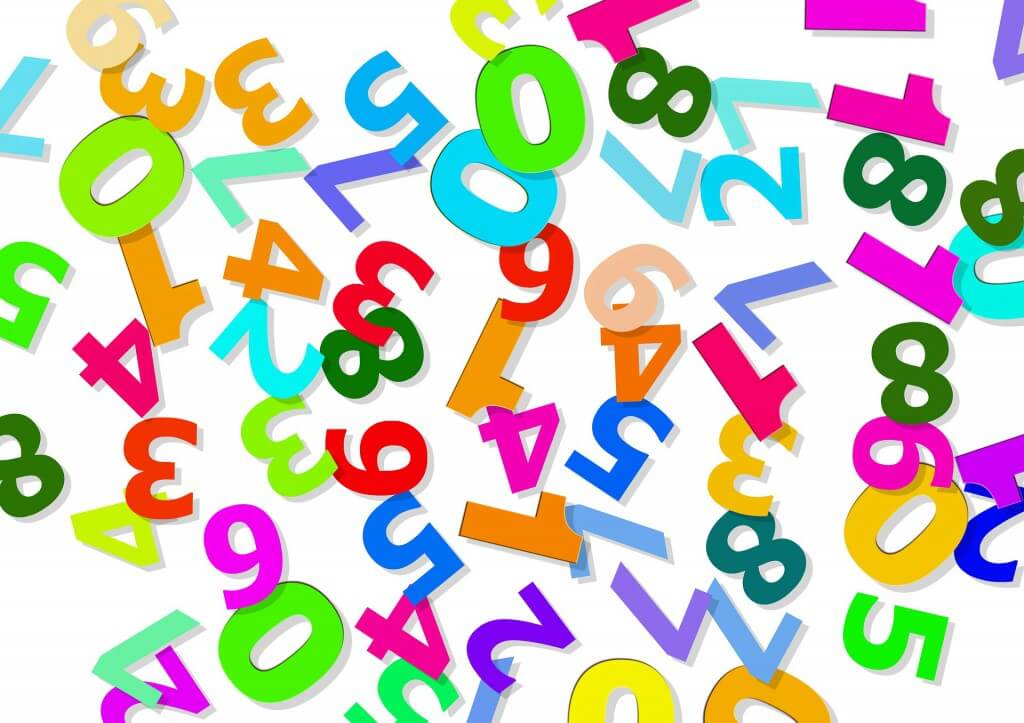
By Alan Karickhoff, Swimming World College Intern
Every year I’m surprised by the number of teens, barely old enough to drive, placing in the finals of their respective events at the U.S. Olympic Trials. I’m also amazed to see Olympians that I watched in their first Olympic Games, when I was 10, still qualifying for the finals heat this year.
For the oldest male finalist qualifier this year, we saw Anthony Ervin (Unattached MAC/UCB), 35, who placed second in the 50 free and fourth in the 100 free. Natalie Coughlin (California Aquatics), 33, represented the oldest female finalist qualifier this year placing eighth in the 100 back. At the opposite end of the timeline, Robert Finke (Saint Petersburg Aquatics), 16, denoted the youngest male swimmer in the finals, placing seventh in the 1500 free. For the women, Cassidy Bayer (Nation’s Capital Swim Club), also 16, placed fourth in the 100 fly and third in the 200 fly.
In the 2012 Olympic Trials, we witnessed both of the oldest finals qualifiers since 1996. Dara Torres (CSSC-FG), 45, placed fourth in the 50 free, and Jason Lezak (ROSE-CA), 36, placed sixth in the 100 free.
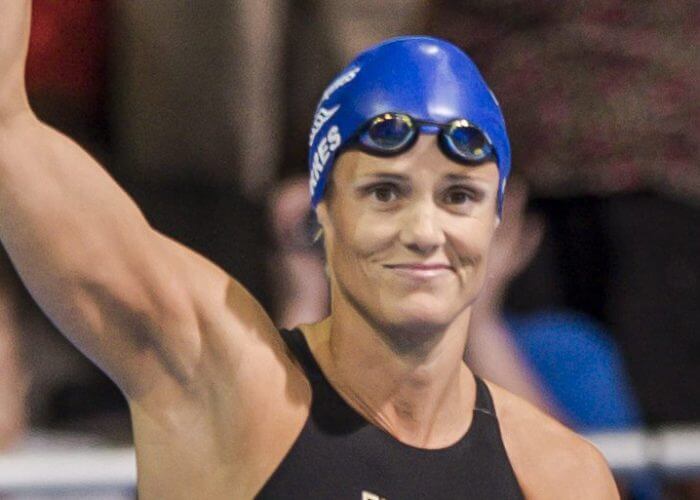
Photo Courtesy: © Peter H. B ick
There is a six-way tie for youngest female finalist qualifier in the Olympic Trials since 1996. They were all 14 in their qualifying years. In 1996, Amanda Beard (Irvine Novas) placed first in the 100 and 200 breaststroke. Jilen Siroky (Mecklenburg) placed second in the 200 breast and fifth in the 100 breast. Beth Botsford (North Baltimore) placed first in the 200 back and second in the 100 back. Jennifer Parmenter (Canyons Aquatics) placed third in the 400 IM, sixth in the 200IM, and sixth in the 200 back.
In 2000, Diana MacManus (Novaquatics) placed fourth in the 100 back.
Then, twelve years later, in 2012, Becca Mann (CAT-FL) placed fifth in the 800 free and 400 IM, and sixth in the 400 free.
For the men, Michael Phelps (North Baltimore) holds the record for youngest Olympic Trials finals qualifier since 1996. At 15 years old, he placed second in the 200 fly.
With the talk of Michael Phelps and Ryan Lochte’s last competitive races on U.S. soil, this year’s Olympic Trials finalists felt like an older group than in past years. We also saw many stars from previous Olympics placing in the top 8: Dana Vollmer, Amanda Weir, Natalie Coughlin, Jessica Hardy, Nathan Adrian, Cullen Jones, and Matt Grevers, among many others. I dove into the data to find some answers to my questions. Unfortunately, results posted online only showed dates back to 1996, but it’s still a good reference with 1,248 observations.
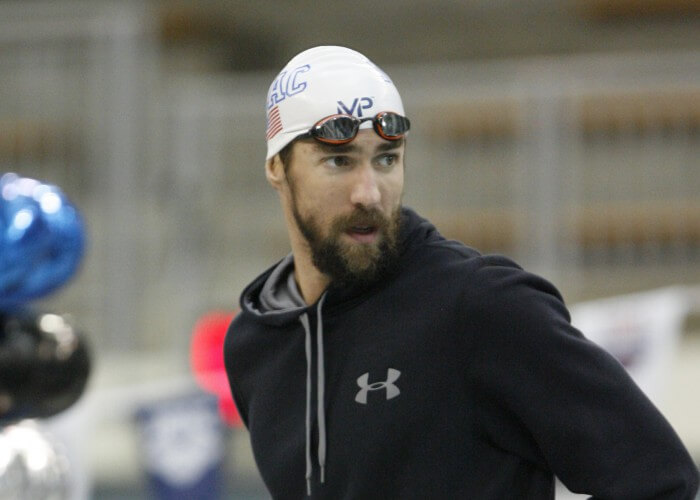
Photo Courtesy: Madeline Olson
Was this a star-studded field? Certainly. Was it the oldest group of top 8 finishers since 1996?
Yes! Overall, the average age in 2016 was 22 years and nearly five months. It’s tied with 2012 as being the oldest two Olympic Trials since 1996. In 1996, the average age was only 20 years and nearly 10 months. Separating men and women, we do not have the same answer. The average age for men in 2012 was 23 years and nearly 10 months. The 2016 women finalists are the oldest group, averaging 21 years and nearly 10 months, which is over two and a half years more than 1996 when their average age was 19 years and about 2 months.
The women have the youngest swimmers to qualify for the finals, but they also have the oldest. Do men or women have the highest average age?
Men. Including every top eight finisher in every event since the 1996 Olympic Trials, the average age for females is 20 years and nearly 10 months. For males, it is 22 years and just over seven months. The average age for men in every event is higher than the average age for women, except for the 100 fly.
Does the event make a difference? It is easy to look at the anecdotal evidence of Dara Torres in the 50 free and Jason Lezak in the 100 free, but is that consistent among the top eight swimmers?
Between events, the average ages can be multiple years apart. There is a strong bias toward older swimmers qualifying in the top eight for the 50 free and the 100 free. Younger swimmers fill the other events almost evenly, but for women there is an average age under 20 for the 400 free, 800 free, 200 IM, and 400 IM. For men, the two lowest aged events are the 1500 free and 200 back, but most ages are 21 or 22.
Four fun facts with the most affect on the averages:
In 1996 the average age for females in the 400 IM was only 16 years and about 5 months!
If you’re a recent college graduate in your early 20s, then you might not want to hang up the goggles yet. The average age for males in the 50 free this year was 26 years and almost 4 months!
The average age for females in the 50 free in 2012 was 26 years and nearly 5 months!
In 1996, the average age for the top two finishers in the women’s 200 breaststroke was 14!
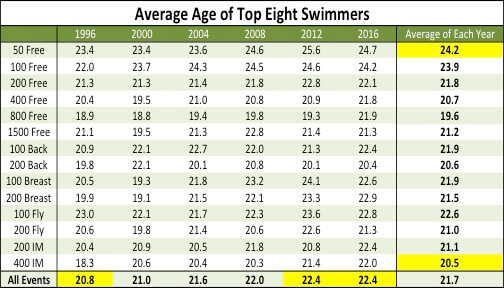
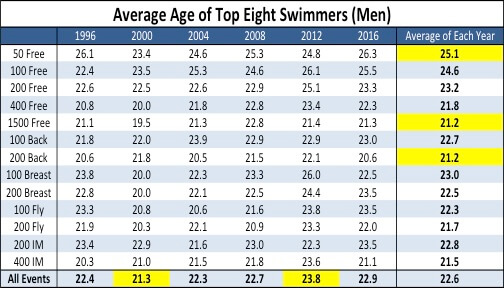
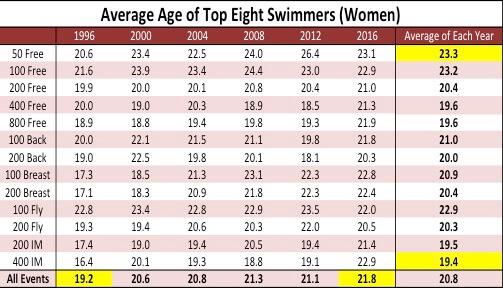
Results provided by USA Swimming: U.S. Olympic Trials Past Results, Current Results



